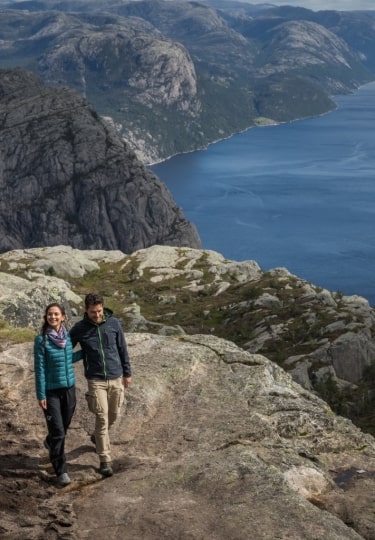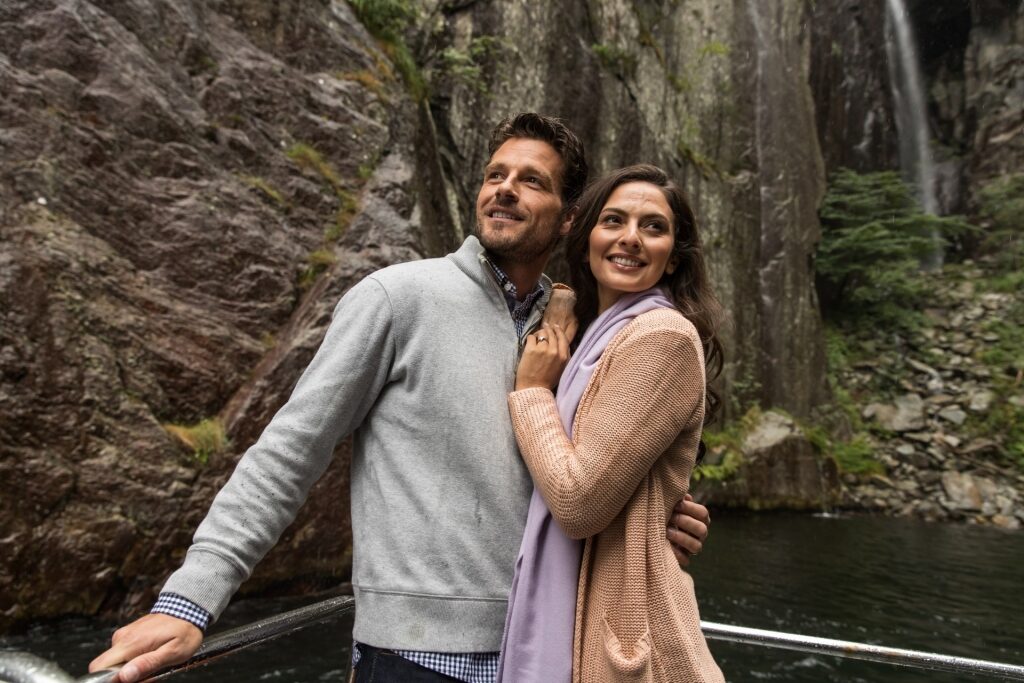Norway is home to towering mountains, expansive glaciers, deep coastal fjords, and every landscape in between. You’ll find both real history—such as preserved Viking ships and medieval architecture—and local legends involving trolls, magic, and all sorts of mystery.
Whichever path you take, adventure awaits. Hike to Pulpit Rock in Stavanger, cave walk in Trollkirka, or step aboard the Flåm Railway to travel along a branch of Norway’s longest and deepest fjord.
Many of Norway’s most noteworthy attractions are easy to access from Oslo, Bergen, Alesund, and Molde, making it easy to combine a morning museum visit with a hike or a stroll as well as a break to sample the local specialties of seafood, game, and berries.
Here are some of the best things to do in Norway.
Feel Like a Royal in Oslo
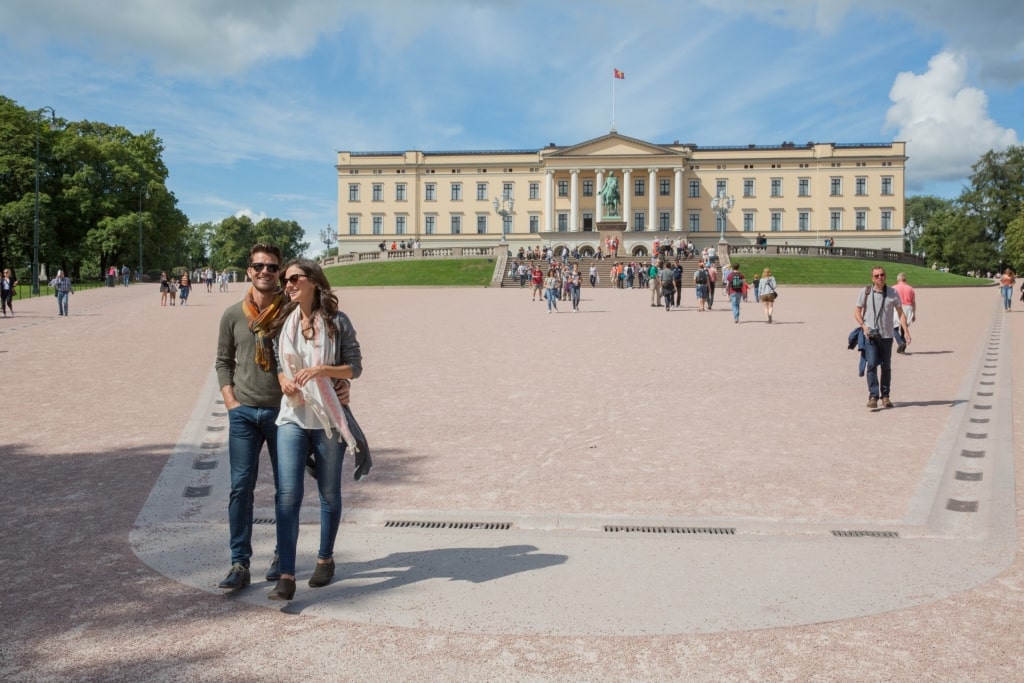
Royal Palace, Oslo
On your unofficial royal tour of Oslo, consider the Royal Palace your first stop. It was the French-born King Charles III who first ordered that the palace be built and unfortunately for him, it wasn’t completed until about five years after his death.
While Charles never had the chance to reside within the Royal Palace, Oscar I and his wife, Josephine, did.
Today, the Neoclassical palace is the home of Norway’s King Harald V and Queen Sonja. If you’re just passing through, try to time your visit for 1:30 p.m. to see the changing of the guard. Otherwise, book a more comprehensive tour that is offered during the summer season.
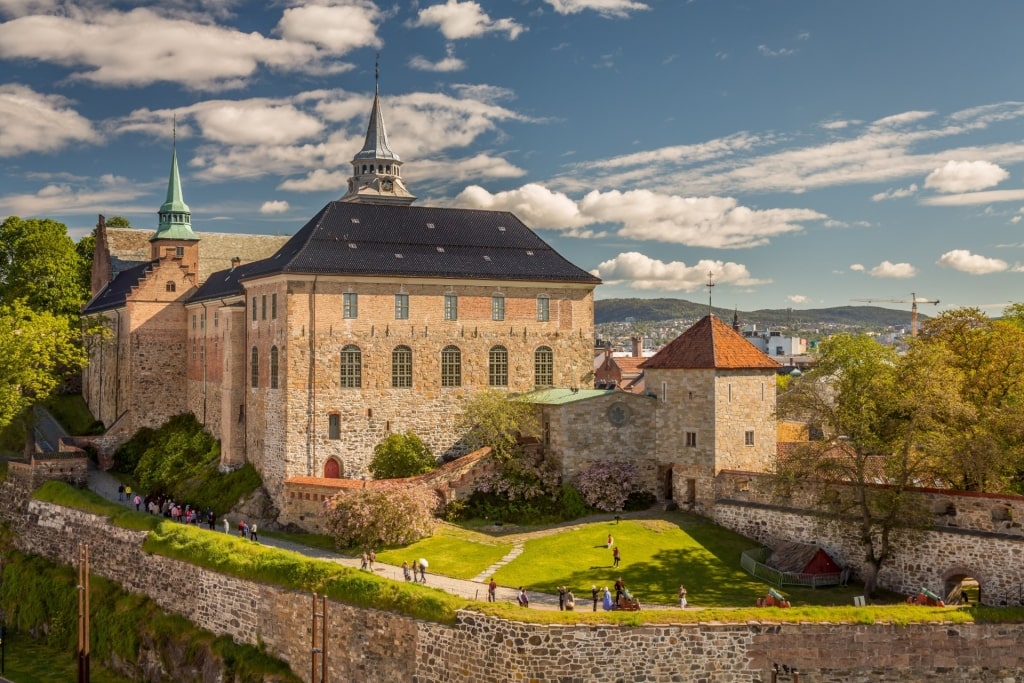
Akershus Fortress, Oslo
Alternatively, take in the views from Akershus Fortress, a medieval castle in Oslo that was built to protect and provide for the city. The castle dates back to 1299, when it served as a royal residence.
However, it transformed into a fortress in 1592 and was later rebuilt into a castle in Renaissance architectural style between 1637 and 1648.
Read: Extraordinary Castles in Norway to Explore
Visit the Art Nouveau District in Ålesund
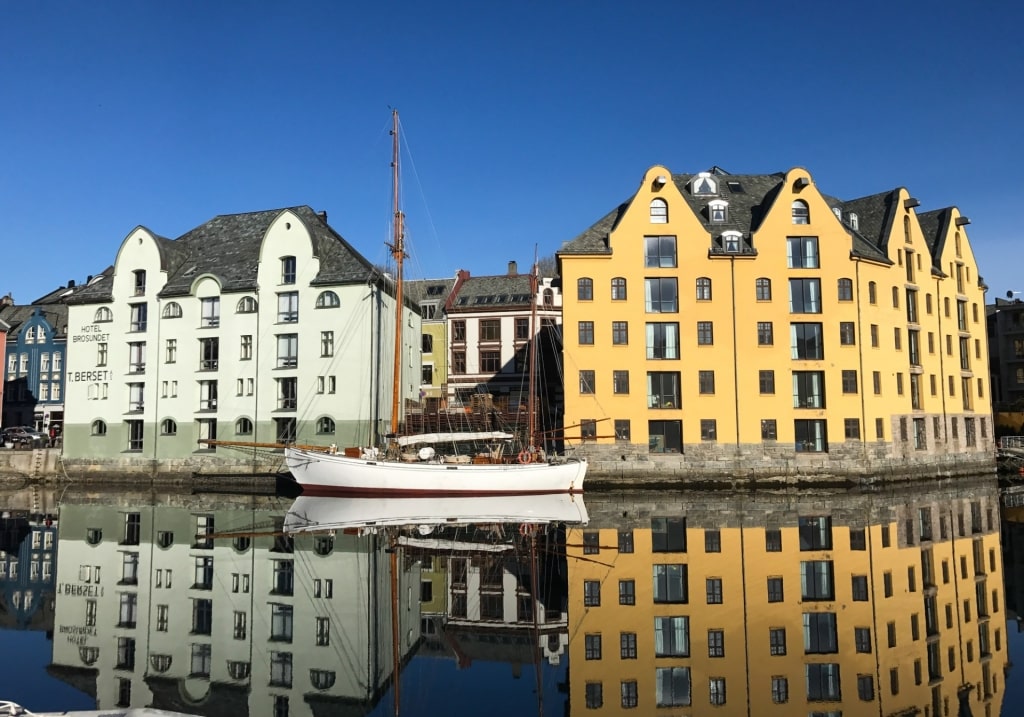
Downtown Ålesund
The Norwegian port town of Ålesund had a tough winter in 1904, when a massive fire burned down 850 houses and rendered 10,000 inhabitants homeless, all in the span of about 16 hours.
Despite such a devastating setback, locals and workers from all over Europe successfully rebuilt the city. The architects designing the homes for the rebuild were greatly influenced by Art Nouveau, a style that was very popular at the time.
Today, you can see colorful buildings decorated with towers, turrets and other design ornamentations. Ålesund is an extremely walkable town, not to mention a very photogenic one, and is one of the most important Norway attractions.
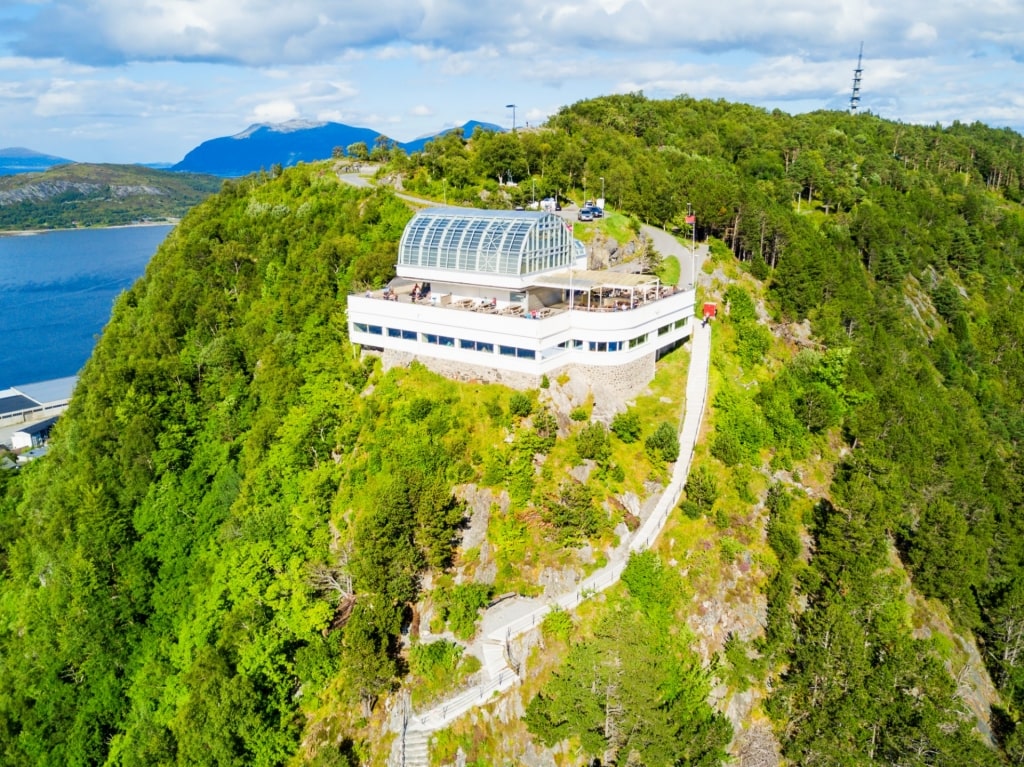
Fjellstua, Ålesund
The famous viewpoint, called Fjellstua, is just 418 steps uphill from the city park. From there, you can see the vibrant-colored Art Nouveau buildings reflected on the water below, creating a rainbow effect even on gray days.

Ålesund Museum
For a crash course on the port town’s history, visit the Ålesund Museum. You’ll leave with a deeper understanding and appreciation of Ålesund and the people who live here.
Not in a museum mood? No problem. As Ålesund is one of Norway’s most important fishing harbors, you can soak up local Norwegian culture through cuisine. Most restaurants serve hot bowls of fish soup and other seafood dishes including fresh crab and crayfish.
Follow the Path of the Trolls in Trollstigen
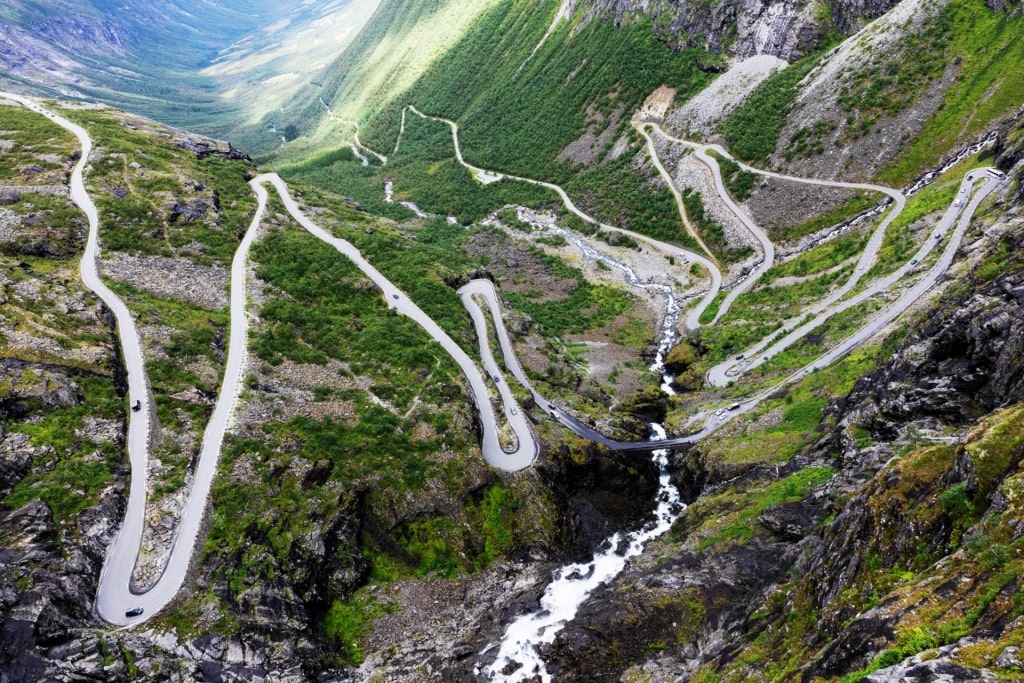
Trollstigen
Trollstigen, also called “The Troll’s Road” in Norway’s Reinheimen National Park, is a fantastically twisty road that snakes its way up and along the mountainside. From a distance, it’s hard to believe that cars and buses can even navigate this route.
Of course, the real treasure of Trollstigen is the view from the top, which reaches 2,811 feet above sea level. Before reaching the top (or coming back down), you need to pass 11 sharp hairpin turns, at an almost impossible-seeming gradient.
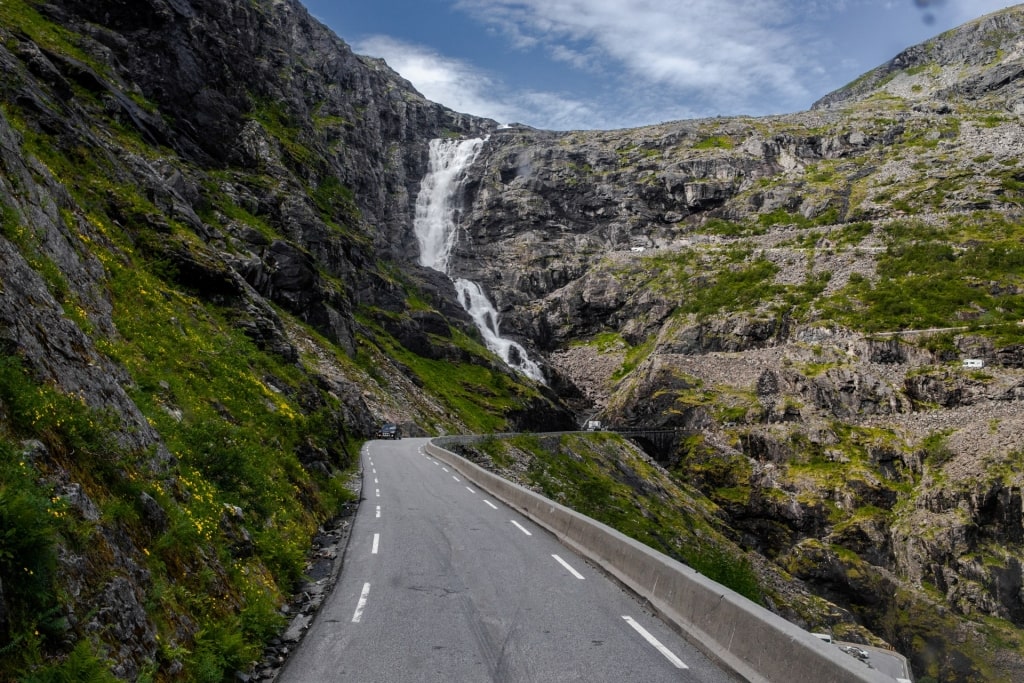
Stigfossen Waterfall
Known as Norway’s “Golden Route”, the journey offers some of the most magnificent views of the landscape below— deep fjords, valleys, lush greenery, and Stigfossen Waterfall once you reach the top.
Wondering what the deal is with Norwegians and their fondness for trolls? According to Norwegian folk legend, the trolls wander through the mountains of Trollstigen every night—but come daylight, they turn into stones.
Chase Waterfalls in Geirangerfjord
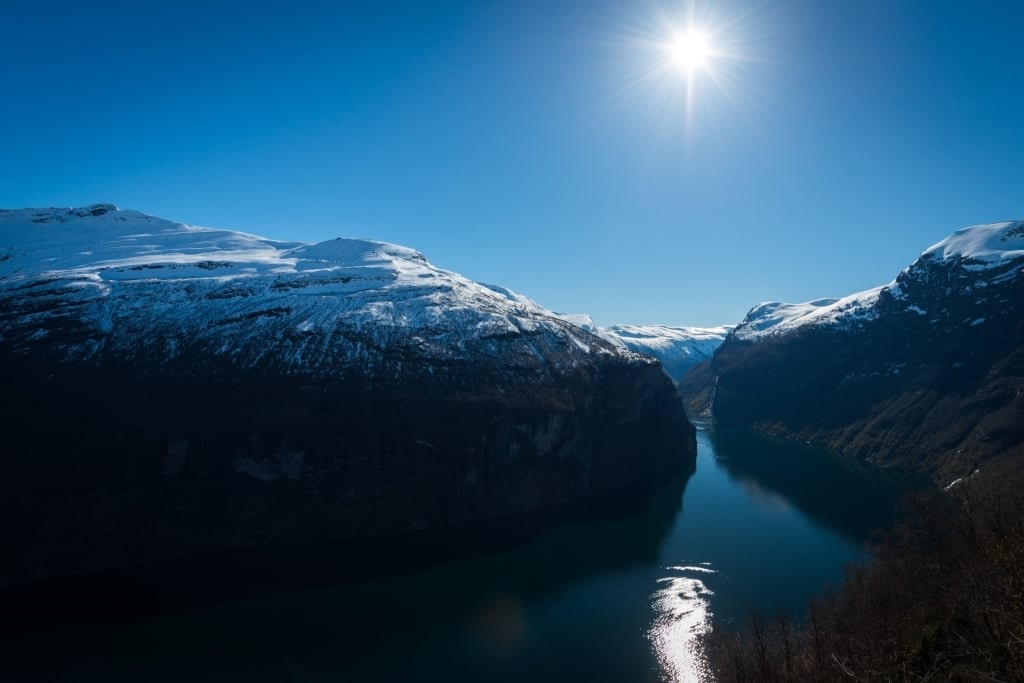
Geirangerfjord, Geiranger
No trip to Norway is complete without a visit to Geirangerfjord. Geiranger is a sleepy village in the western part of Norway, nestled at the head of what is probably the most famous and beautiful of Norway’s fjords. Spending a day here is one of the most popular things to do in Norway.
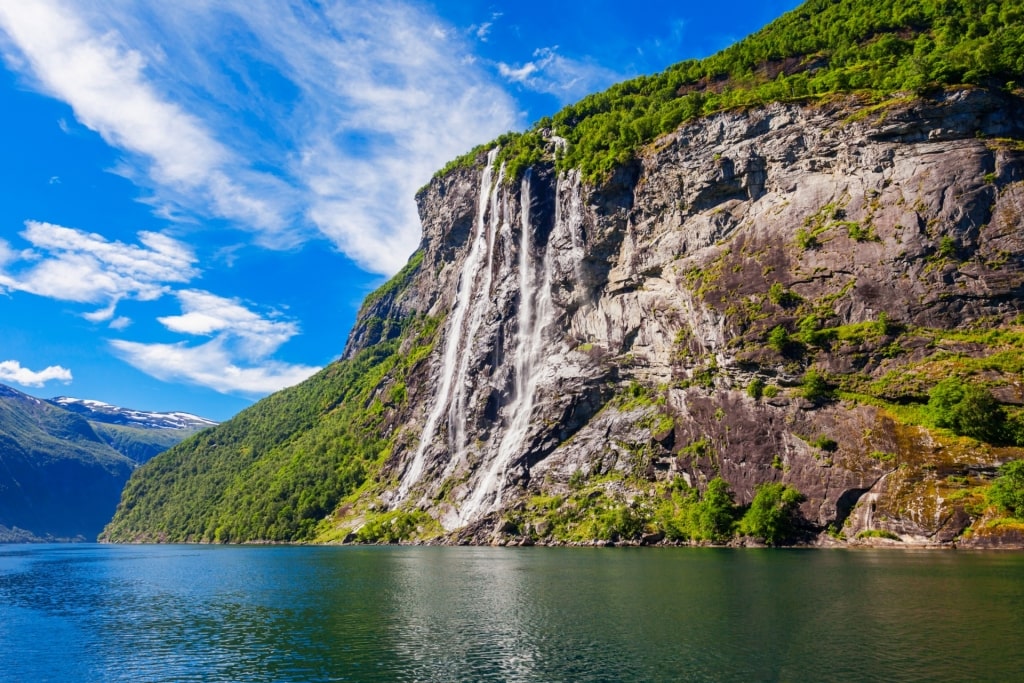
The Seven Sisters Falls, Geiranger
There are a few Norwegian waterfalls to keep an eye out for. The Seven Sisters Falls, as its name suggests, consists of seven separate streams. Just offside the Seven Sisters Falls is “The Suitor” waterfall. According to legend, the suitor is trying to impress the sisters.
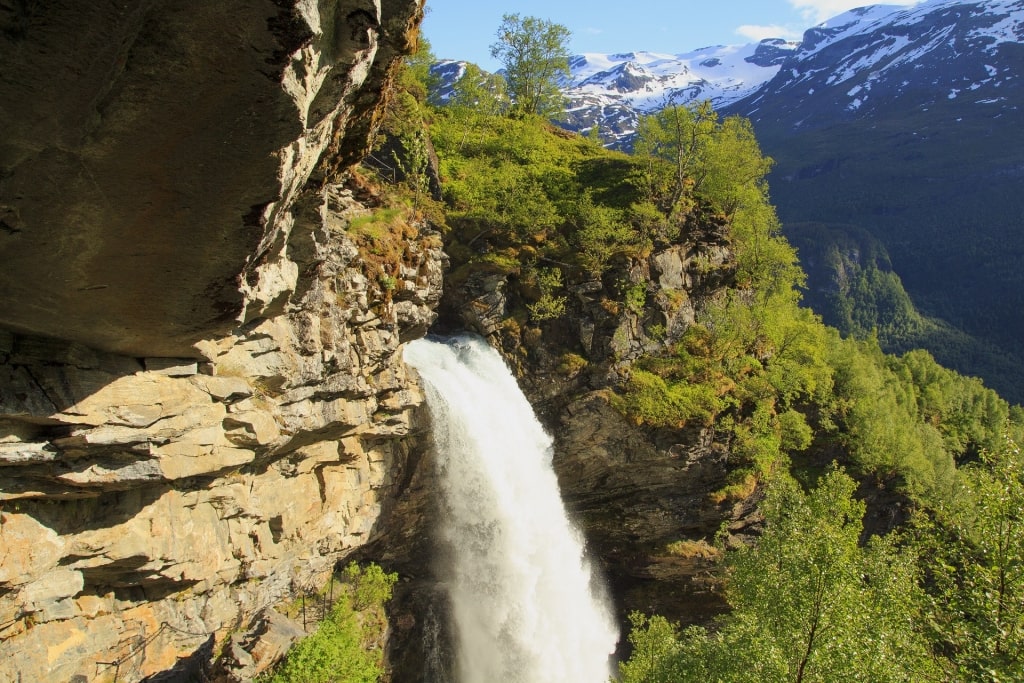
Storsæterfossen, Geiranger
If you’re up for an adventure, there’s an easily accessible hike to Storsæterfossen waterfall. There are two options here: one hike is longer but easier and the other is shorter but steeper. When you reach the falls, you’ll stand right underneath it, so be prepared to get wet.
If you don’t want to hike but have a head for heights, the Geiranger Skywalk platform offers the highest view of the fjord. At 4,900 feet above sea level, the platform juts out from a cliff, with a sheer drop below.
Marvel at Colorful Bryggen in Bergen
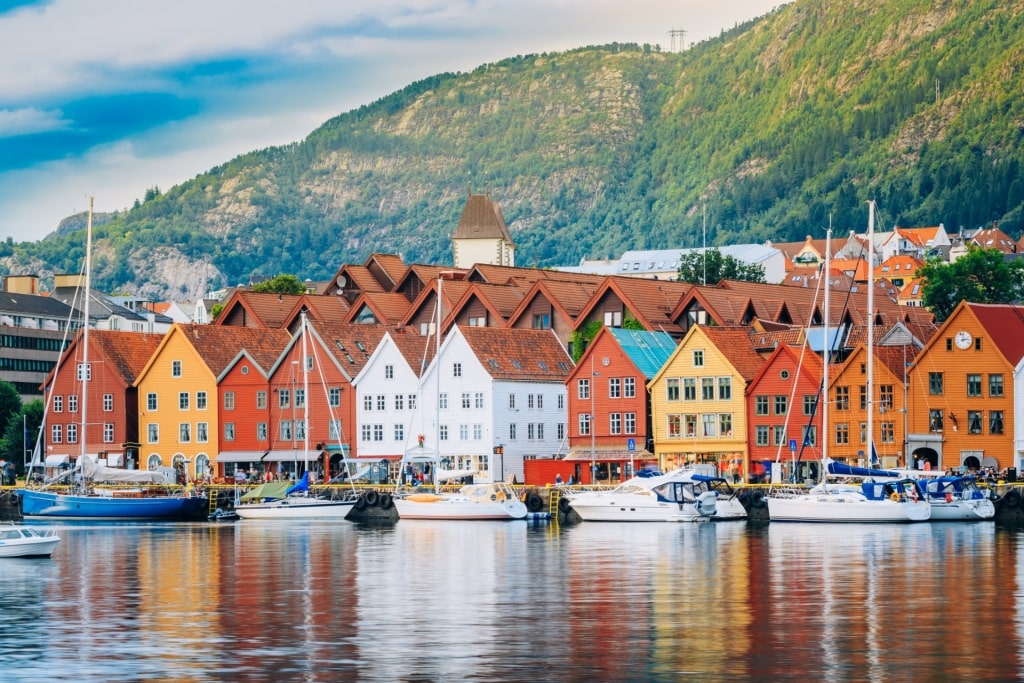
Bryggen, Bergen
Beautiful Bergen is a former Viking stronghold guarded by deep fjords, towering mountains and sweeping glaciers. Bryggen—the historic harbor district of Bergen—is one of Norway’s top attractions, and for good reason.
Bergen has, however, suffered several fires throughout the years, during the period when most houses were built of wood. The most devastating was the great fire of 1702, which turned the city to ashes and required a complete rebuild.
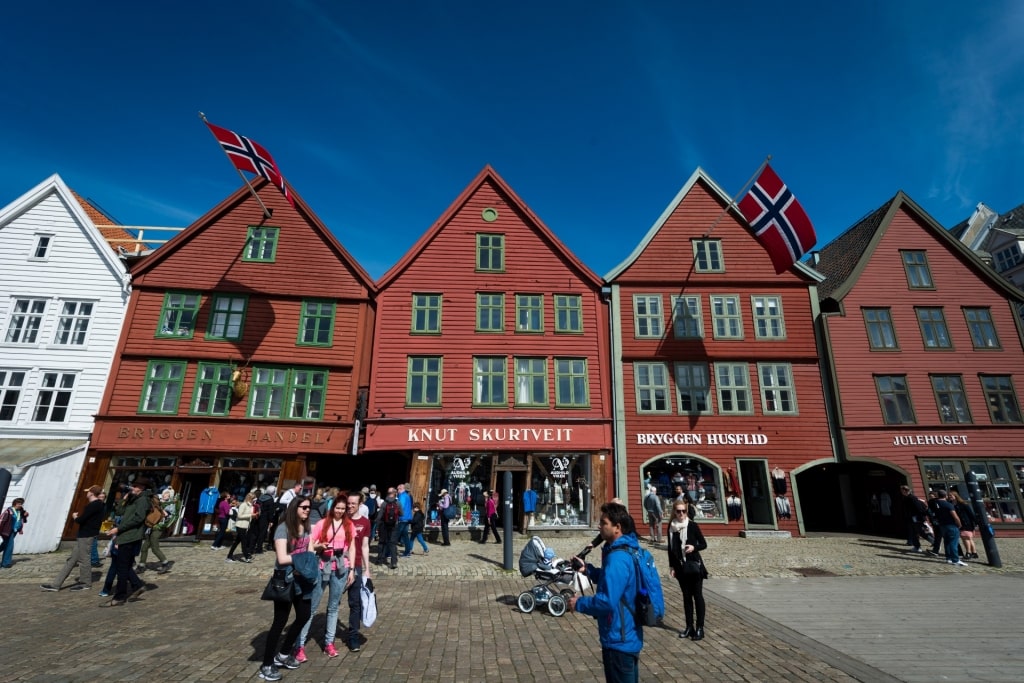
Bryggen, Bergen
After the fire, locals chose to rebuild the city just as it was before. So the Bryggen you see today, a parade of warehouses in shades of ochre, dusky pink, white, and rust looks very similar to the original foundations dating back to the 12th century.
As such, it is included on UNESCO’s World Heritage List, and visiting is one of the best things to do in Bergen.
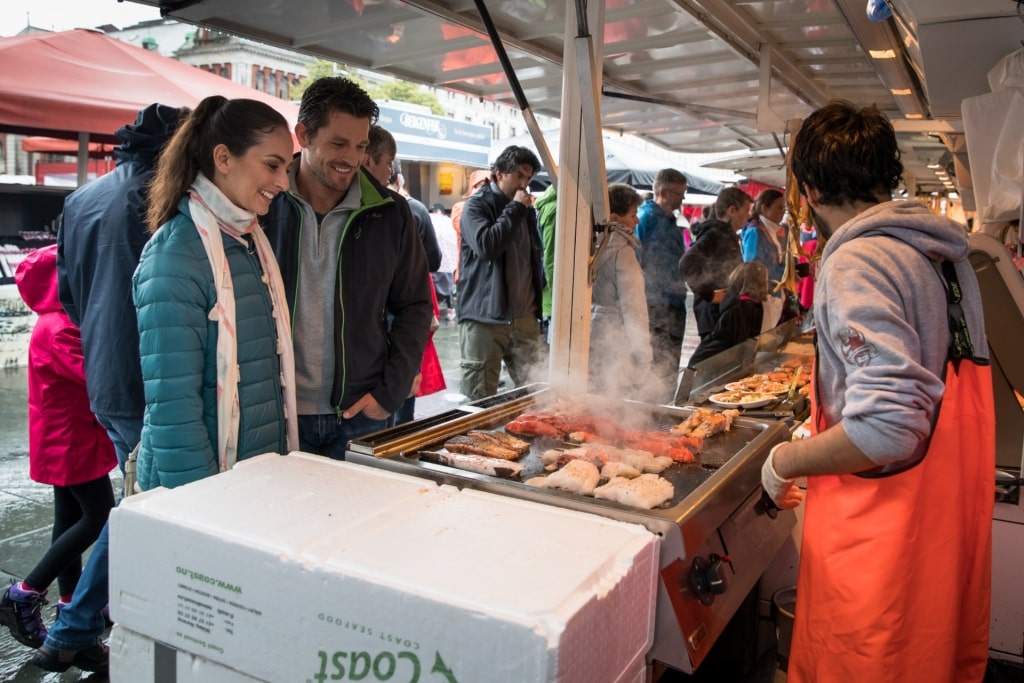
Fish Market, Bergen
Take a walk to the famous Fish Market, stopping for fish soup, cured salmon, herring and shrimp dishes, or snap a photo at the Bergenhus Fortress.
On the hunt for authentic souvenirs? Hidden behind the facades of Bryggen are a selection of small shops, art galleries and artists’ studios.
Sail Along Nærøyfjord
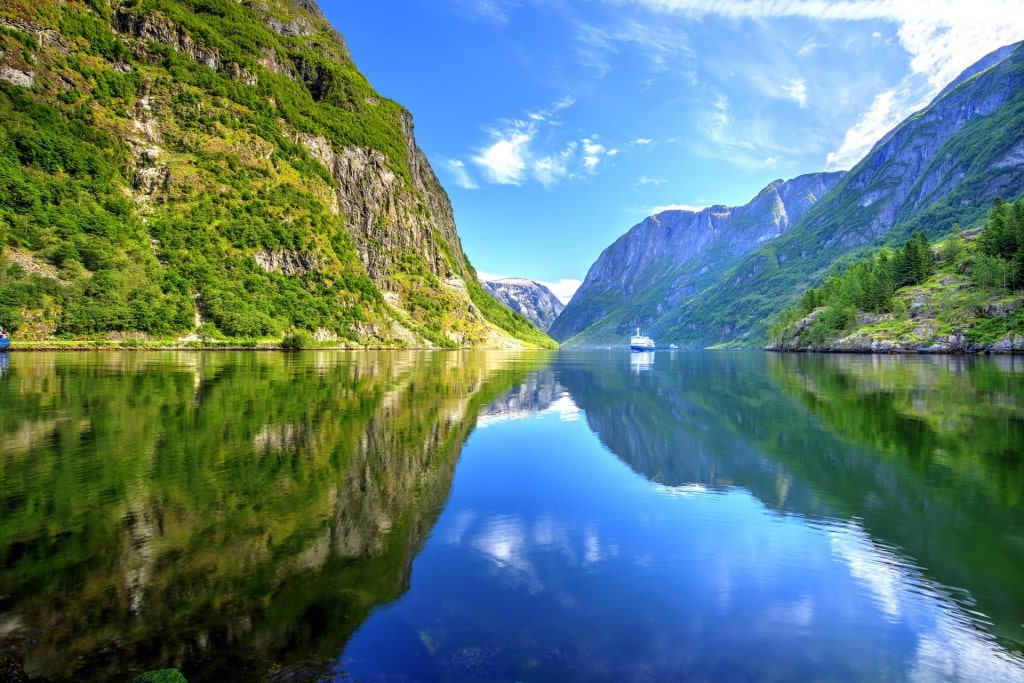
Nærøyfjord
Nærøyfjord is one of Western Norway’s most impressive fjords—for context, there are more than 1,000 fjords around the country—and is also a UNESCO World Heritage Site.
Nærøyfjord, as the name suggests, includes passages that are very narrow, surrounded by steep mountains on either side, waterfalls cascading in ribbons over the towering cliffs. The best way to admire the scenery is from a small boat.
Amid this dramatic landscape, you’ll find traditional farms and small villages built into the hillsides along the fjord. If you tour the area by boat, as many travelers choose to do, you might even see goats grazing on the farms and seals basking on the rocks.
Read: Beautiful Places to Visit in Norway
Museum Hop in Oslo
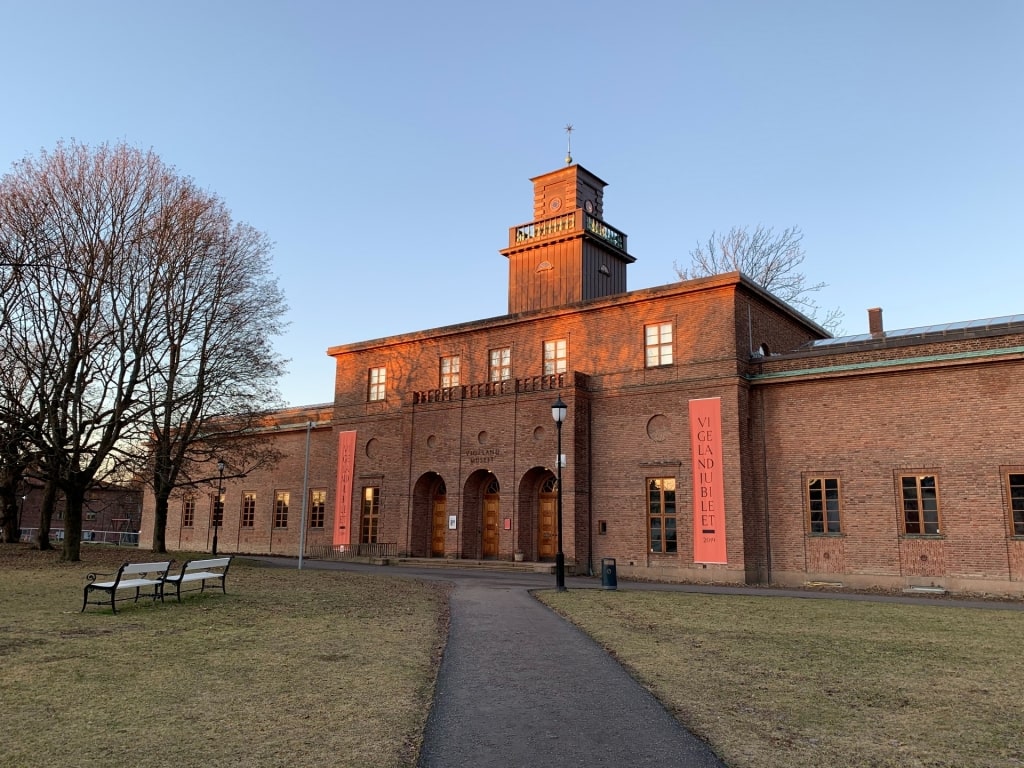
Vigeland Museum, Oslo Photo by the Vigeland Museum on Wikimedia Commons, licensed under CC BY-SA 4.0
Some of Norway’s most noteworthy museums are located in Oslo. The Vigeland Museum is a sculpture museum and a great example of neo-classical architecture in Norway.
The collection includes sculptor Gustav Vigeland’s early works that include portraits and monuments, plus plaster sculptures in Vigeland Park.
Then there’s the Norwegian Maritime Museum which highlights Norwegian maritime history as well as the shipbuilding techniques and underwater technology needed to operate these large vessels.
As for art museums, The National Museum houses a range of artistic styles, while the Munch Museum focuses on the famed artist’s life and work.
Read: Things to Do in Oslo
Board the Flåm Railway

Flåm Railway, Flåm
The town of Flåm is nestled in Aurlandsfjord, an arm of the mighty Sognefjord. The Flåm Railway, which starts here, is known as one of the most scenic train journeys in the world.
The train runs from the end of Aurlandsfjord to Myrdal station on the Oslo-Bergen line and takes you 2,800 feet up into the wilds of the mountains of Norway.
Along the way, you’ll pass through western Norway’s vast and varied landscape, all from the comfort of a charming, vintage train car. In about one hour, you cover a lot of ground, climbing 2,833 feet.

Kjosfossen waterfall, Flåm
The train runs through the old Flåm village center and past the old church, as well as mountains, rivers and small farms. There’s a short stop at the Kjosfossen waterfall, giving you just enough time to disembark and snap a photo or two of the waterfall.
The railway itself is quite an engineering feat. Construction began in 1923 and ended in 1940. Covering a distance of 12.5 miles, the railway line is one of the steepest in the world, with 80 percent of the journey running on a gradient of 5.5 percent.

Flåm Railway, Flåm
The train clatters through 20 tunnels, most of which were built entirely by hand. The most impressive tunnel actually takes a 180-degree turn inside the mountain.
Read: Best Things to Do in Flåm
Hike to a Glacier in Jostedalsbreen National Park
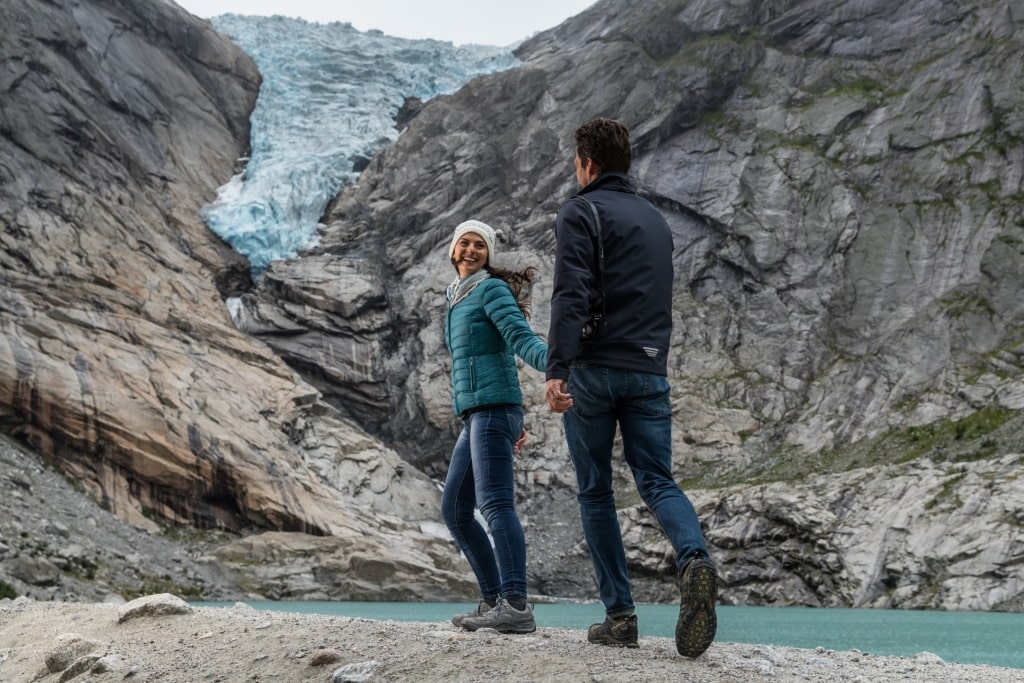
Jostedalsbreen National Park, near Olden
Jostedalsbreen glacier is the largest in continental Europe and it takes up almost half of the Jostedalsbreen National Park. This landscape combines lush vegetation with the blue-white ice and tumbled rocks of the glacier and its various arms.
From the port of Olden, you can easily reach Briksdalsbreen, one of these arms, hanging off a cliff and feeding a milky-blue lake.
There are various hiking trails here, the easiest being a mile-and-a-half walk from Briksdal’s Mountain Lodge to the glacier lake. If you prefer not to walk, an electric “troll car” can whisk you to the Norwegian lake.
Learn About Vikings in Avaldsnes
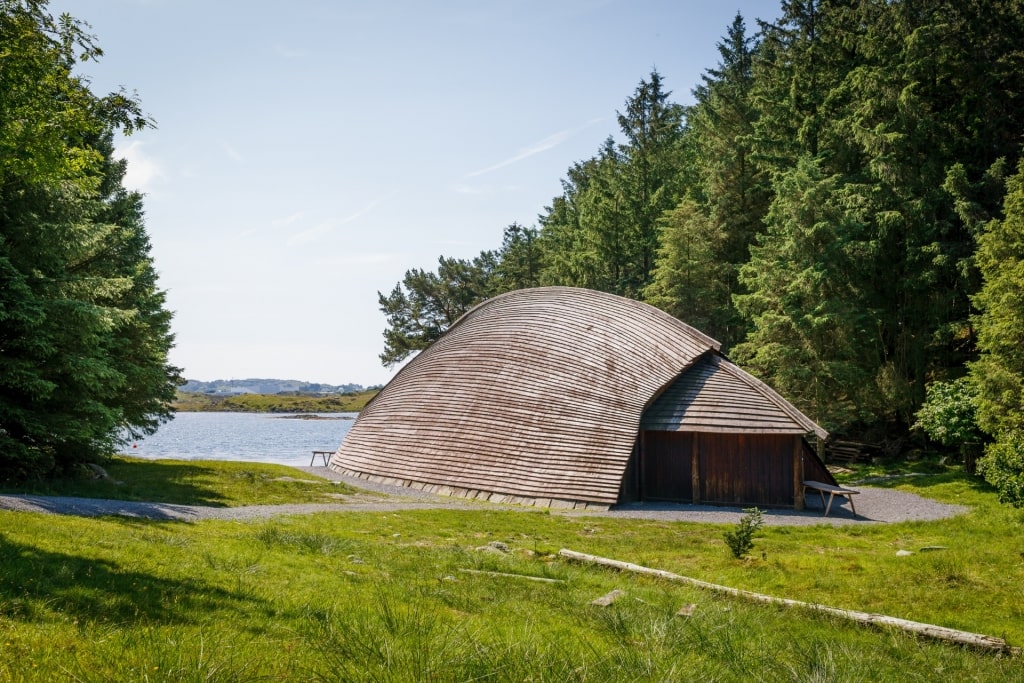
Avaldsnes, near Haugesund
Avaldsnes is a former Viking settlement on the island of Bukkøy, near Haugesund. Setting foot here feels as if you’ve traveled back in time.
The farm once served as the home of King Harald Fairhair, and the reconstructed buildings help recreate what life was like in the pre-Christian era.
For a deep dive into Viking history, take a guided tour around the settlement’s medieval church and monuments. At the Norway History Centre, kids can even try on Viking costumes for fun.
Explore the Trollkirka Caves
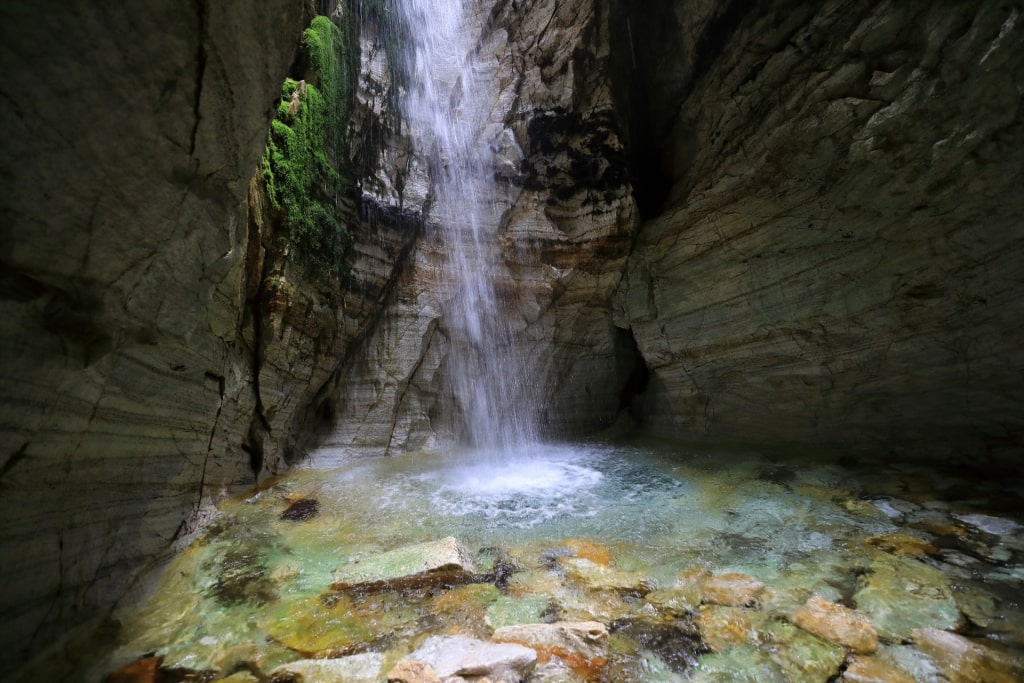
Trollkirka Caves, near Molde
As scenic as Norway is on land and by sea, don’t underestimate the beauty that lies beneath. Cave walking in Trollkirka, near Molde, is a challenge but arguably one of the more unusual things to do in Norway, as you’ll splash along underground rivers and see waterfalls tumbling down the rock faces.
There are two entry points in Trollkirka, one of which has a larger opening and a river running through it. Once inside the marble and limestone cave, your guide will lead you to the “Kirka”, which is an area with high rock ceilings where you can relax before continuing deeper into the caves.
Keep in mind that as exciting as this experience is, it’s not for everyone, particularly those who are claustrophobic and uncomfortable in small spaces. Wear sturdy shoes – and prepare to get damp.
Hike to Pulpit Rock, near Stavanger
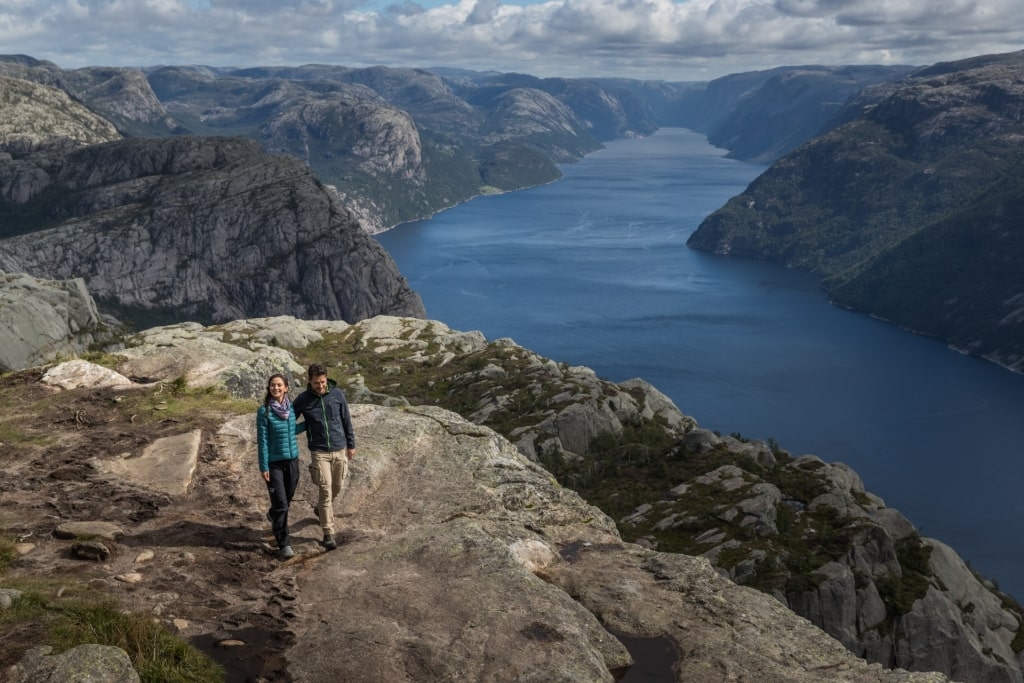
Pulpit Rock, near Stavanger
History buffs and outdoor adventurers will find common ground in Stavanger, a city in southwestern Norway that mixes old and new.
One of the best things to do in Stavanger is to visit Gamle Stavanger, the 18th-century old town, a cluster of more than 250 whitewashed clapboard cottages, their gardens vibrant with flowers. After a stroll here, visit Stavanger Cathedral, the oldest in Norway, built between 1100 and 1125.
The real prize for walkers, though, is Pulpit Rock, one of the best hikes in Norway, with its extraordinary block towering 1,800 feet above the Lysefjord.
It’s a challenging walk from the start point, 45 minutes’ drive from Stavanger, and around four hours round-trip, with steep sections. But the views, photo opportunities, and kudos for getting there are unrivaled.
Feel the Spray of Tvindefossen Waterfall near Flåm

Tvindefossen Waterfall
Mountain hiking trails, bucolic farmland, and cows grazing in wildflower meadows surround this captivating waterfall in the fjord region of Norway.
Tvindefossen—one of the best things to do in Norway—cascades 360 next to the E16, a highway linking Flåm to Bergen. Tvindefossen is just a few minutes’ drive from Voss, a lakeside hamlet known for its adventure sports, including white water rafting and skydiving.
Travelers can witness Tvindefossen from the roadside, though it’s best admired by following the path from the car park to its base to feel the refreshing spray. There is a souvenir shop and restrooms at the car park and plenty more facilities in Voss, including restaurants, cafés, and shops.
Read: What Is Norway Known For?
Take the Ferry to Utsira From Haugesund
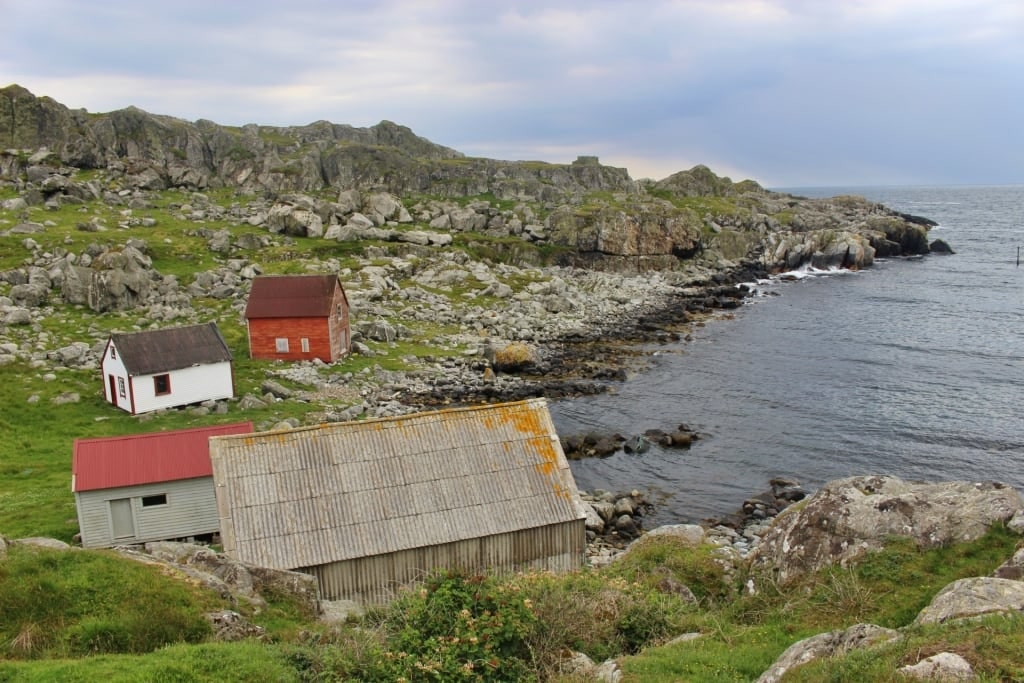
Utsira
One of the best things to do in Norway is to make the 70-minute ferry journey from Haugesund to Utsira, a tiny island just off the mainland in the North Sea.
This speck of land is easy to explore on foot, taking around 30 minutes to get from the north to south, and roughly one hour to get from east to west, with hiking trails, coastal lookouts, and bird-watching spots aplenty.
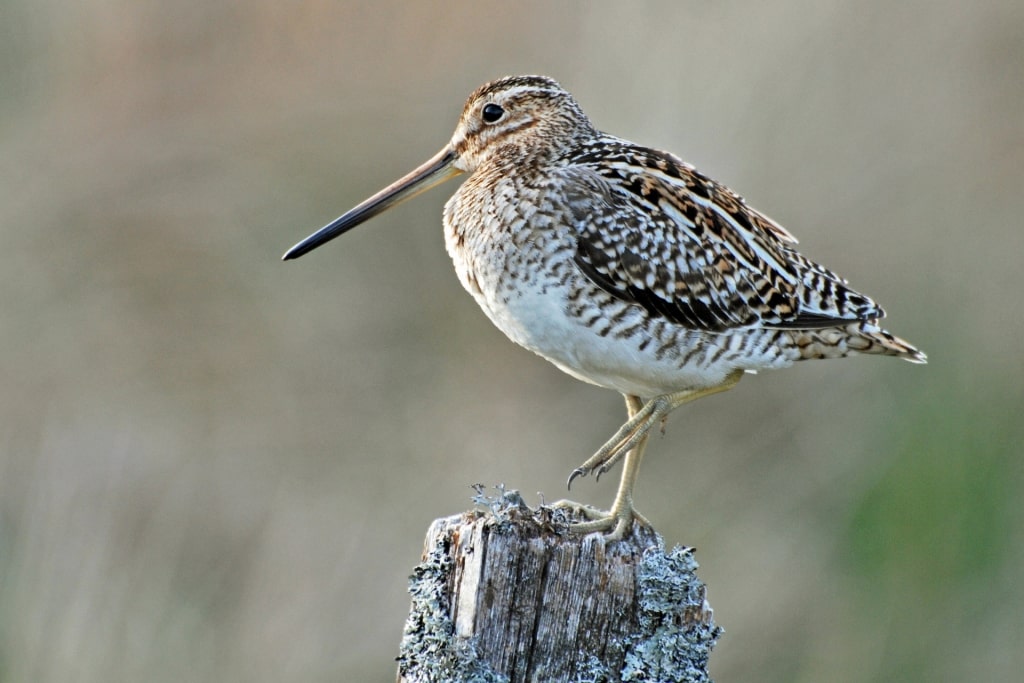
Arctic snipe
Utsira is, in fact, a mecca for birdwatchers, with the island drawing over 300 different species, from dwarf swans to Arctic snipes.
As well as spotting some of the island’s colorful bird life, take in the street art around Nordvikvågen, the island’s small harbor village, with silos, buildings, windmills, and rock faces adorned with vivid works.
Wander past Nordvikvågen’s twee clapboard houses before walking the short distance to Dahmsgård, a seafood restaurant inside a rust-red building in the middle of the island. Here, you can order plates of sweet langoustine and fresh bread rolls to mop up the homemade herby butter.
Ride Loen Skylift in Loen, near Olden
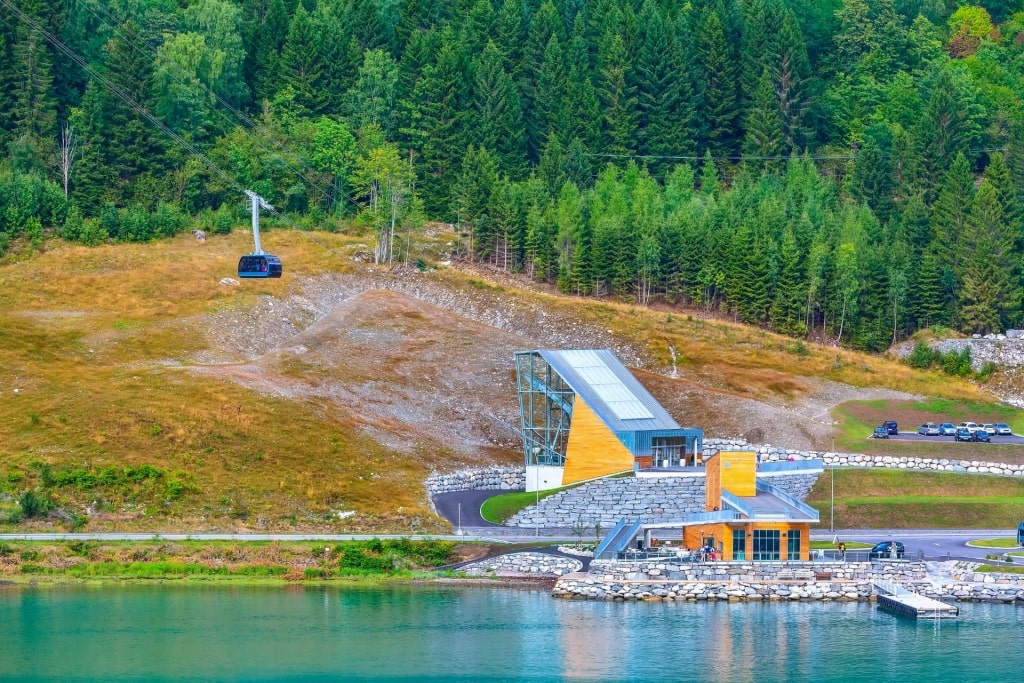
Loen Skylift
Loen Skylift whisks adventurers through the air to an eye-watering height of 3,316 feet, making it one of the steepest cable cars in the world.
Gaze down at the glistening Nordfjord from one of the Skylift’s two 35-person cable cars as you ascend to the top of Mt. Hoven, a journey which takes roughly five minutes.
When you reach the top, choose a breezy hike to take in the surrounding landscape of Jostedalsbreen National Park. Routes offer both easy walks and expert-level rambles.
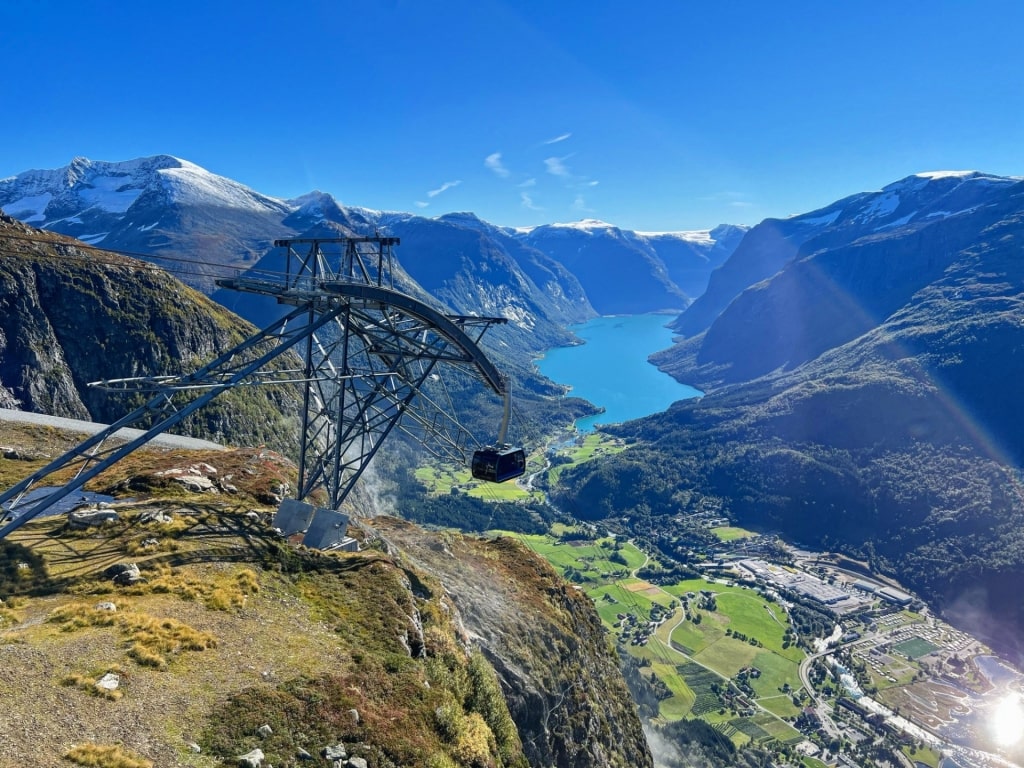
View from Loen Skylift
Book a table at the mountaintop Hoven Restaurant to savor Norwegian dishes of cured salmon or smoked reindeer followed by moules frites or cod loin. Burgers and pizzas are also on the menu. There’s also a souvenir shop and a rooftop café with warm cinnamon buns, ice cream, and velvety hot chocolate.
During summer, serious thrill-seekers can tackle the Via Ferrata Loen climb, a demanding five to six-hour trail that’s best accomplished with a guide.
The route takes in the Gjølmunne suspension bridge, the longest via ferrata bridge in Europe, spanning 394 feet. The hike starts at Loen Active Shop in Loen, returning to the fjord by the Skylift.
Visit the Arctic Cathedral in Tromsø
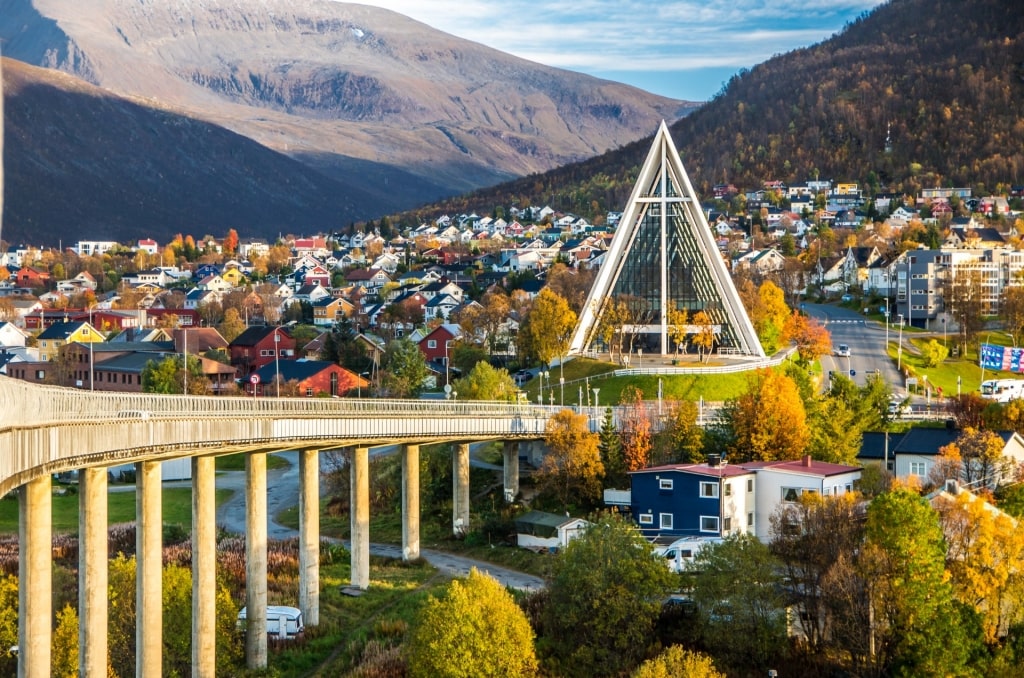
Arctic Cathedral, Tromsø
The 1965-built Tromsdalen Church, better known as the Arctic Cathedral, is one of Norway’s most distinguished buildings for its striking design.
Situated on a hill on the east side of Tromsø, this concrete church is fashioned in the shape of jagged mountains and affords sublime views of the surrounding landscape, including Tromsø Sound and the Tromsø Bridge.
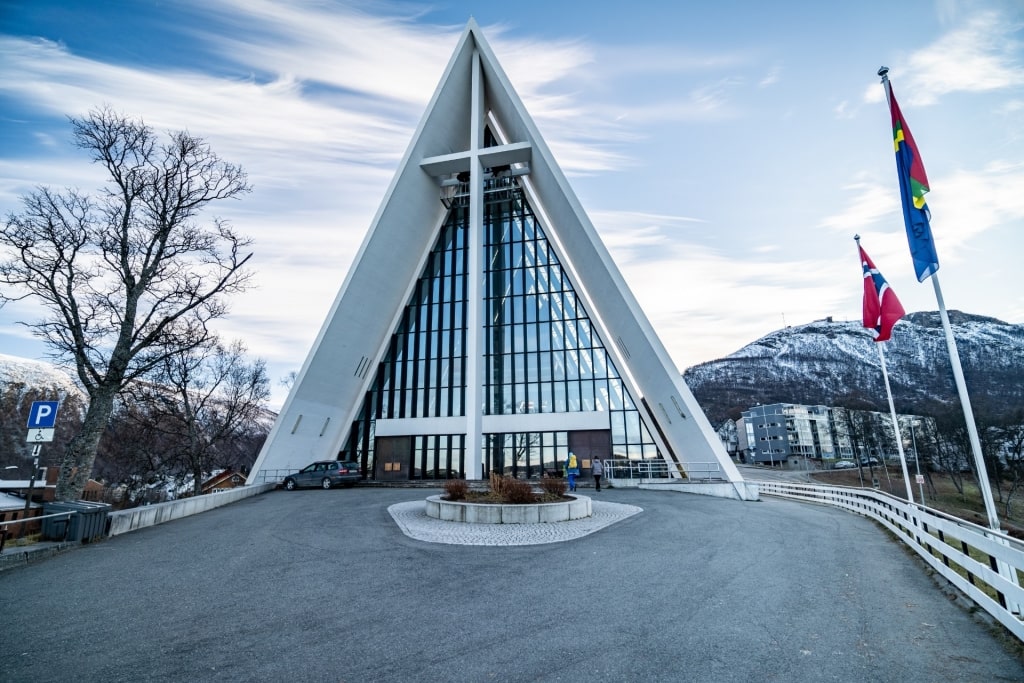
Arctic Cathedral, Tromsø
Admire the mosaic glass design at the church’s main entrance. The symbolic glasswork was designed by Norwegian artist Victor Sparre, depicting three rays of light beaming from God’s hand.
Inside, elegant oak pews, large tiered chandeliers, and a 2,940-pipe organ add to the spectacular drama of this landmark church.
If your visit coincides with summer, you will be treated to views of the Arctic Cathedral bathed in the glow of the midnight sun.
Soak up the Scenery of Lake Lovatnet in Stryn, near Olden
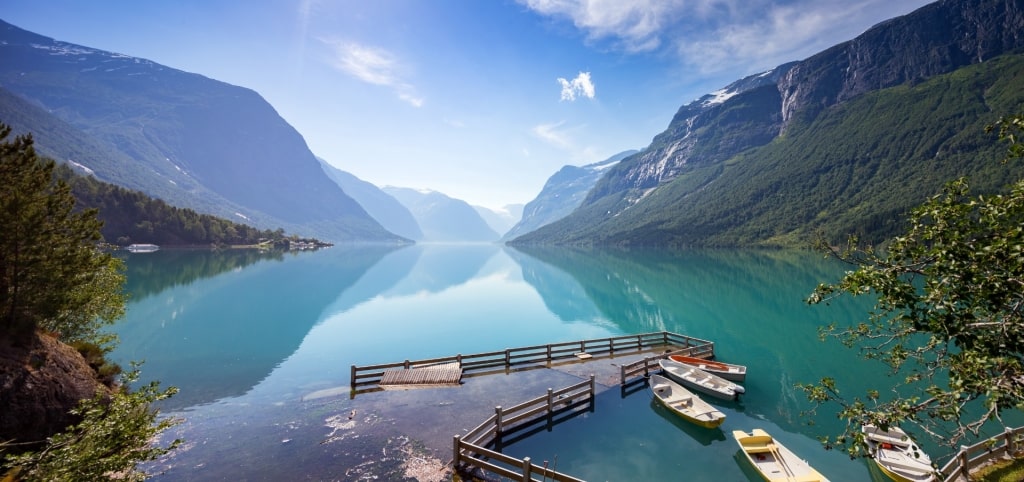
Lake Lovatnet, Stryn
A short drive from the village of Olden, Lovatnet is a teal-hued lake that takes its color from the glacial meltwater that trickles down from the surrounding mountains.
During summer, visitors can join a leisurely boat ride on the lake aboard MS Kjenndal II, which operates from May to September, between Sande in the north and Kjenndalstova in the south.
Lovatnet’s water is utterly captivating, mirroring the lofty landscape of waterfalls and snow-capped mountains around it. Pack a bathing suit and towel. With temperatures peaking around 71°F in the warmer months, you could enjoy a soul-nourishing dip. After, warm up with a coffee and waffles at cafe Båtutleige, on the north shore of the lake.
Explore Sommarøy, near Tromso
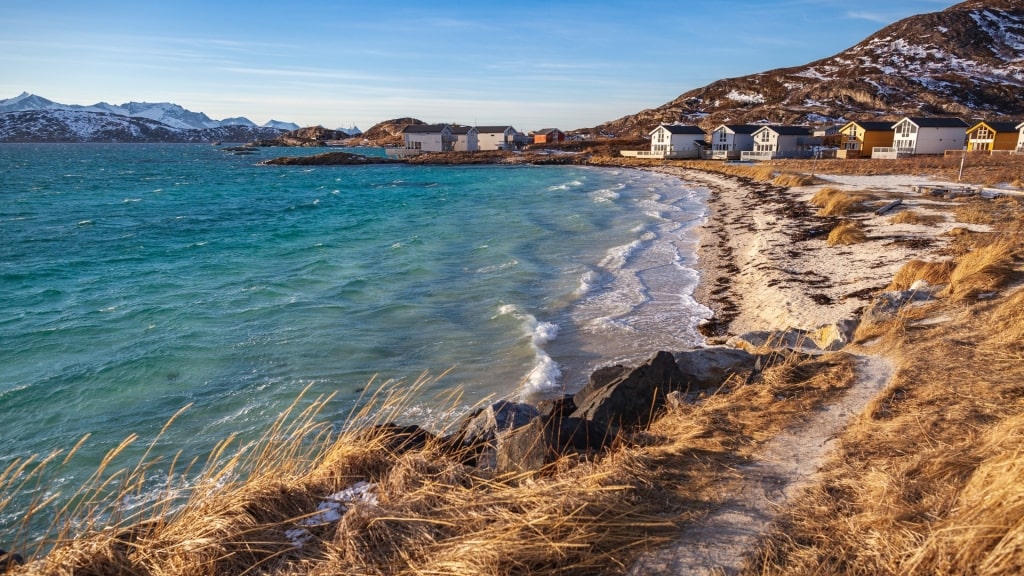
Sommarøy, near Tromso
Lying around 35 miles west of Tromsø, Sommarøy is a fishing community surrounded by clear sapphire waters with tropical-white beaches. During summertime, the sun shines around the clock and wildflowers flourish on the side of green mountains.
Reach Sommarøy by a scenic drive that includes crossing the cantilevered Sommarøy Bridge. There are plenty of photo opportunities along the way, with the route skirting Norway’s Arctic coastline, dotted with quaint cabins, waterfront saunas, and fishing boats.
Enjoy Sommarøy’s slow pace as you walk on Reina or Steinsvika Beach. Hire kayaks or join a guided kayak tour with Sommarøy Adventure in search of hidden coves and swooping sea eagles. Sommarøy Adventure also offers electric bike rental for travelers keen to explore Sommarøy’s stunning scenery on two wheels.
Capture a Bird’s-Eye View of Oslo at Stovner Tower
Opened in 2017 on the outskirts of Oslo, Stovner Tower is a curving treetop walkway, spanning 869 feet and almost 50 feet off the ground. It’s credited as the longest tower in Norway.
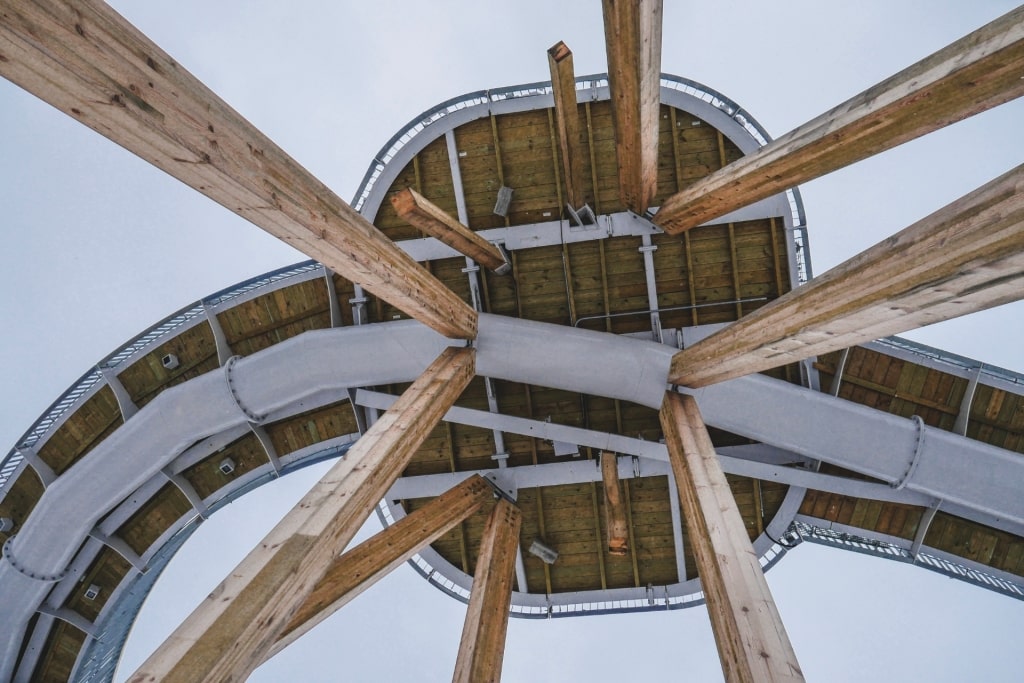
Stovner Tower, near Oslo
Stovner Tower is not a traditional tower, however, instead of rising toward the sky, the timber and steel structure weaves among the trees as a coiling viewing platform.
Visitors can take in views of the surrounding mountains, valleys, the city of Oslo, and the fjord beyond from the walkway, with seating dotted along the route. The elevated plateaus of the tower are designed to mimic birds’ nests, with views offering a bird’s eye perspective.
Stovner Tower is stroller and wheelchair friendly. It’s open year-round and free to explore, with the closest metro stop, Stovner, a five-minute walk away.
Kick Back on Sola Beach, near Stavanger
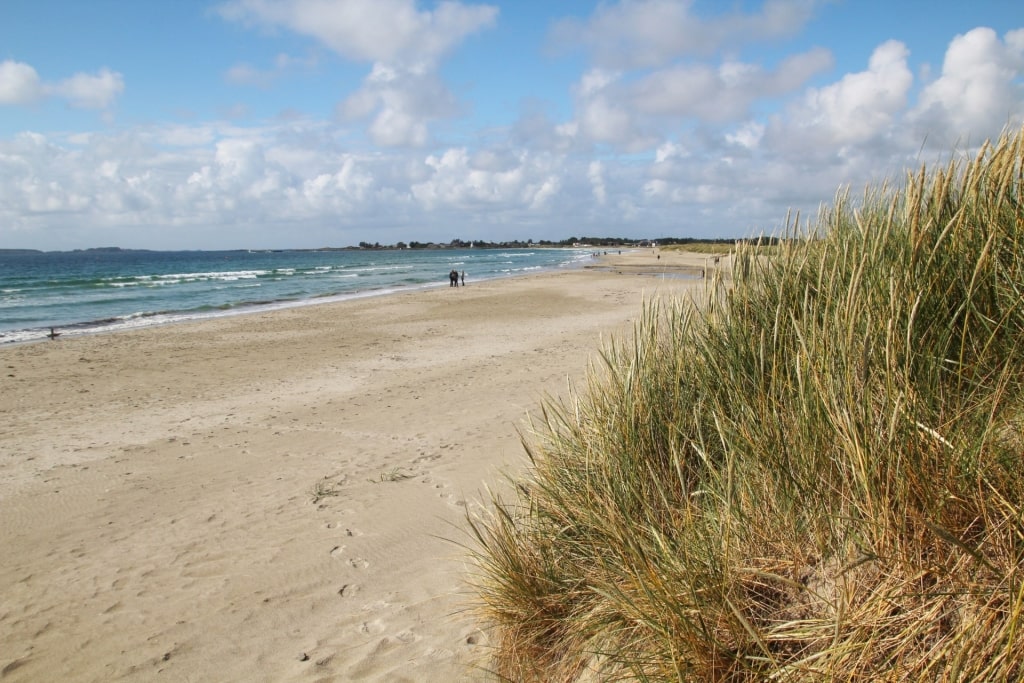
Sola Beach, near Stavanger
Norway is home to many beautiful beaches, including Sola, a short drive southwest of Stavanger. Sola’s crescent sweep of blond sand features rising dunes, with a shallow shore that’s perfect for paddling and swimming.
Surf schools offer lessons for all abilities, with summer a great time for beginners, when the temperature is milder, the sea is more inviting, and the waves are gentler. There’s also a cozy beach bar at the Sola Strand Hotel with inside and outside seating, where visitors can relax with a drink among the dunes.
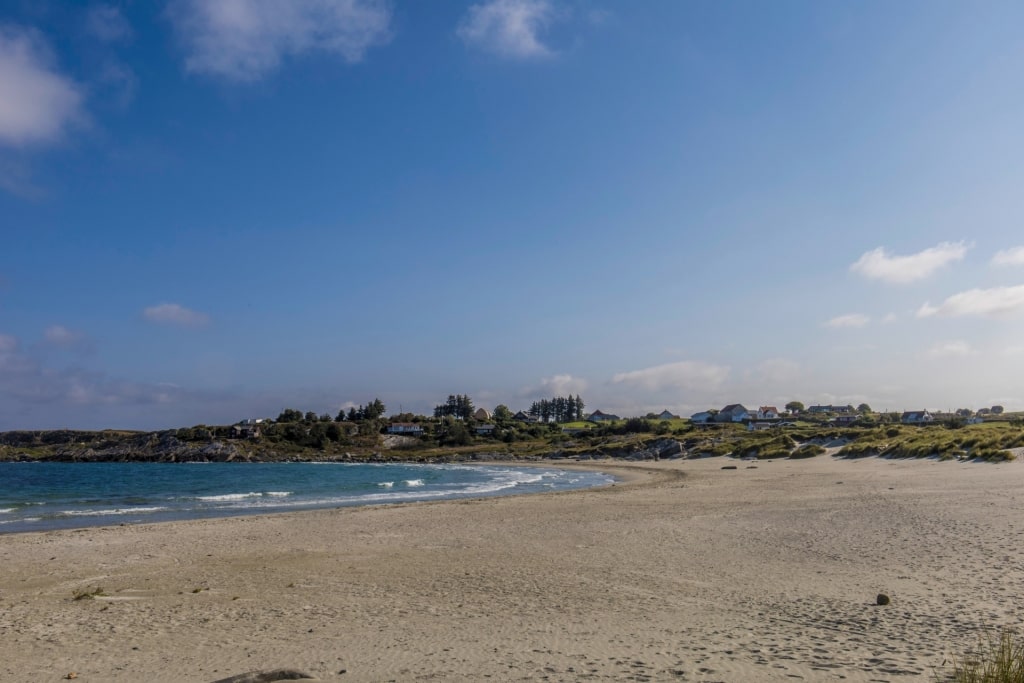
Ølberg Beach, near Stavanger
Walkers can enjoy a coastal hike south toward more golden beaches, including Ølberg and Vigdel. This swathe of North Sea coastline is part of the beaches of Jæren (Jærstrendene), a protected 43-mile stretch from Tungenes in the north to Sirevåg in the south. The region is rich in bird life, including hoards of arctic waders, cormorants, and gulls.
These gorgeous beaches in Norway are festooned with wild plants, too, including endangered saw-wort, sea holly, marsh helleborine, and northern marsh orchid. On Sola Beach, remnants of early 20th century structures are also visible, including the ruins of World War II bunkers.
Climb Mount Fløyen in Bergen
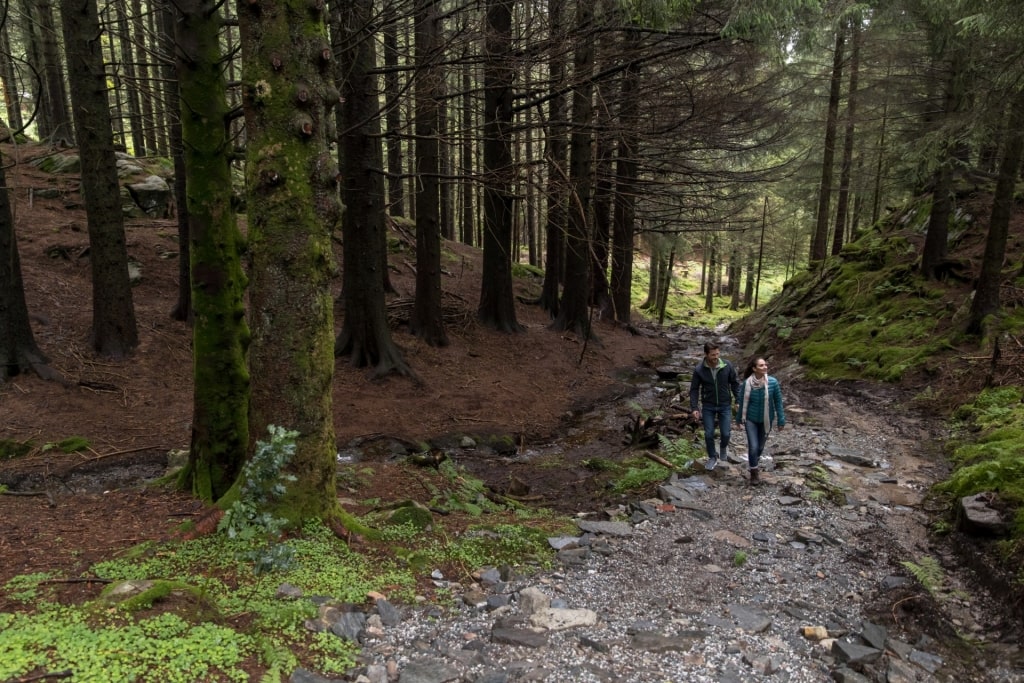
Mount Fløyen, Bergen
Looming large over the port city of Bergen on Norway’s west coast, Fløyen is a 1,050-foot mountain with a cable car, hiking routes, and a playground at the top.
Fløyen offers phenomenal views of Bergen and its surrounding islands, and is popular not only with travelers but with the 10 resident cashmere goats that graze on the mountainside during summer.
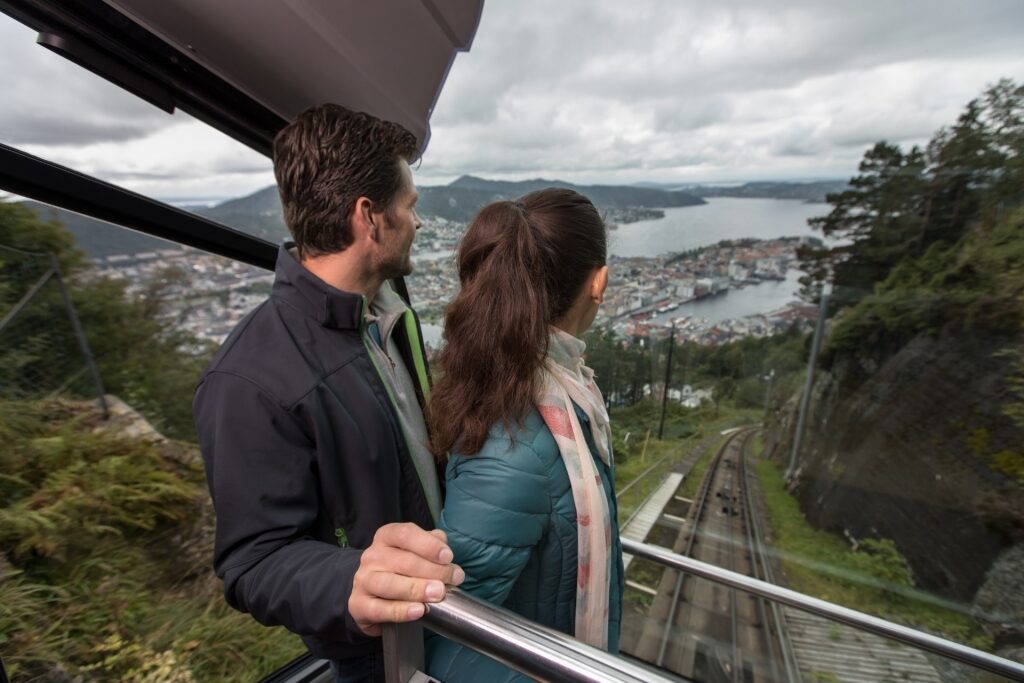
Fløibanen funicular, Bergen
For a gentler trip to the top, choose to take the Fløibanen funicular one way and walk the other. With three intermediate stops, you could take the funicular part of the route up or down, and opt to walk the rest.
The funicular has been in continuous use since 1918, with two carriages tracing the alpine mountain year-round.
If you’re seeking a challenge, walk up the winding road to Mt. Fløyen’s peak from Bergen’s waterfront. The route takes roughly one hour. Stop for a breather at the Tippetue Viewpoint at around the halfway mark for marvelous vistas.
Treat yourself to delicious warm bakes and coffee at Fløistuen shop and café, next to Fløibanen upper station. You could also continue the short distance from the summit of Mt. Fløyen to Skomakerdiket. This picturesque lake offers free canoeing during summer, with paddles and life jackets also provided, and a lakeside café for refreshments.
Discover Flor & Fjære Garden in Stavanger
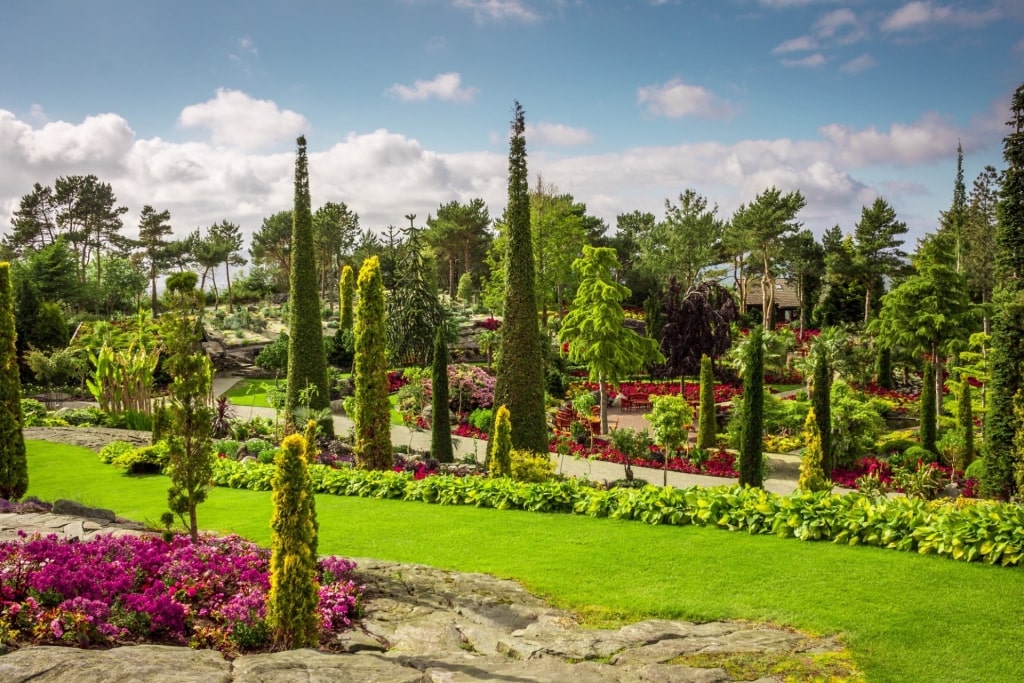
Flor & Fjære Garden, Stavanger
Things to do in Norway don’t get more serene than visiting Flor & Fjære. This sensational garden lies on the northern tip of Sør-Hidle Island, a short distance northeast of Stavanger, at the mouth of the Høgsfjorden.
Flor & Fjære is a privately-owned estate—open seasonally between May and September—and it is essential to pre-book a visit, which also includes a sumptuous three-course lunch. The boat ride from Bekhuskaien in Stavanger to Sør-Hidle takes 20 minutes and is as scenic as the island’s gardens.
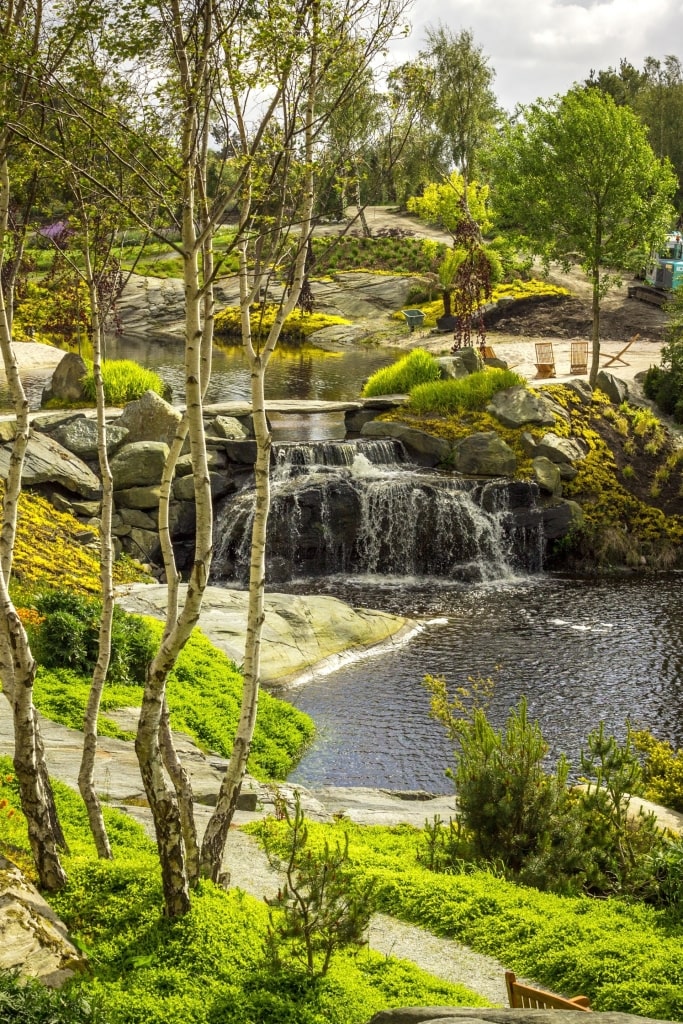
Flor & Fjære Garden, Stavanger
Join a guided 40-minute botanical tour, with the labyrinthine grounds filled with lush exotic plants, ponds, and lakes. The 12.5-acre estate is split into sections inspired by different regions of the world, with manicured paths lined with palm trees and a dazzling array of 50,000 plants planted each spring.
Stop by Flor & Fjære’s white-sand beach and beach bar. There’s also an extraordinary new one-acre greenhouse with flower, herb, and vegetable sections. Inside is also a produce-focused restaurant led by head chef André Mulder, whose seasonal menu utilizes homegrown and locally caught ingredients.
Make a Pilgrimage to Nidaros Cathedral in Trondheim
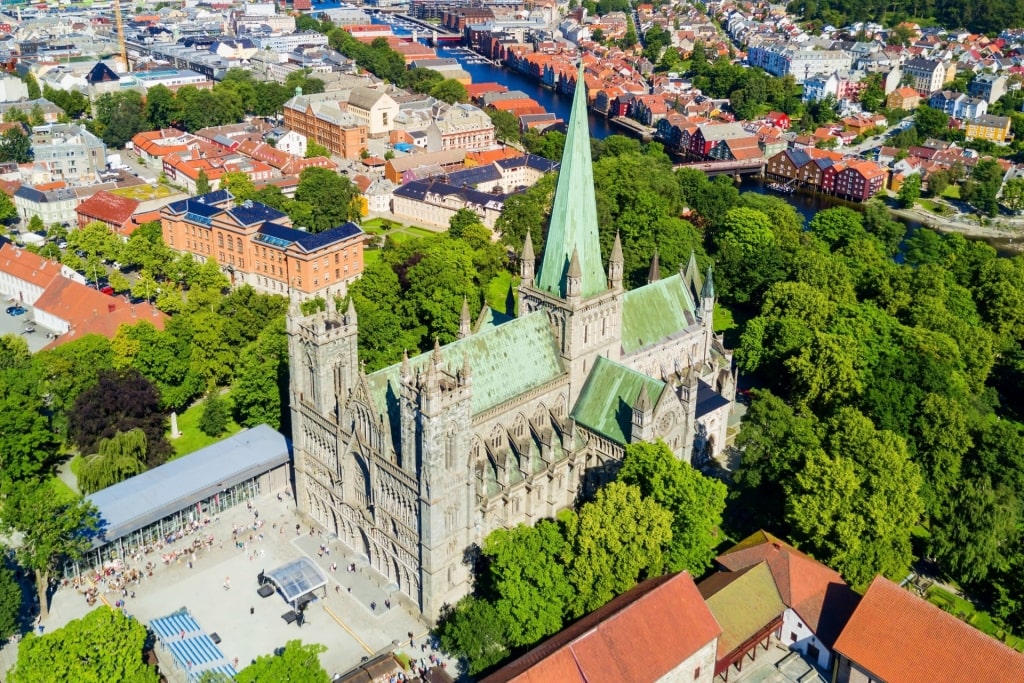
Nidaros Cathedral, Trondheim
With its magnificent sky-piercing copper spire, Nidaros Cathedral towers above Trondheim, Norway’s third-largest city, lying in the center of the west coast. Visiting Nidaros Cathedral is one of the best things to do in Norway and is the final destination of nine pilgrim routes known as St. Olav Ways.
The cathedral is named after the city’s original name, Nidaros, and was built in the 11th century on the burial site of Olav the Holy. Olav was a Viking king and is Norway’s national saint, and his holy shrine is what brings thousands of pilgrims from around the world to this medieval cathedral.
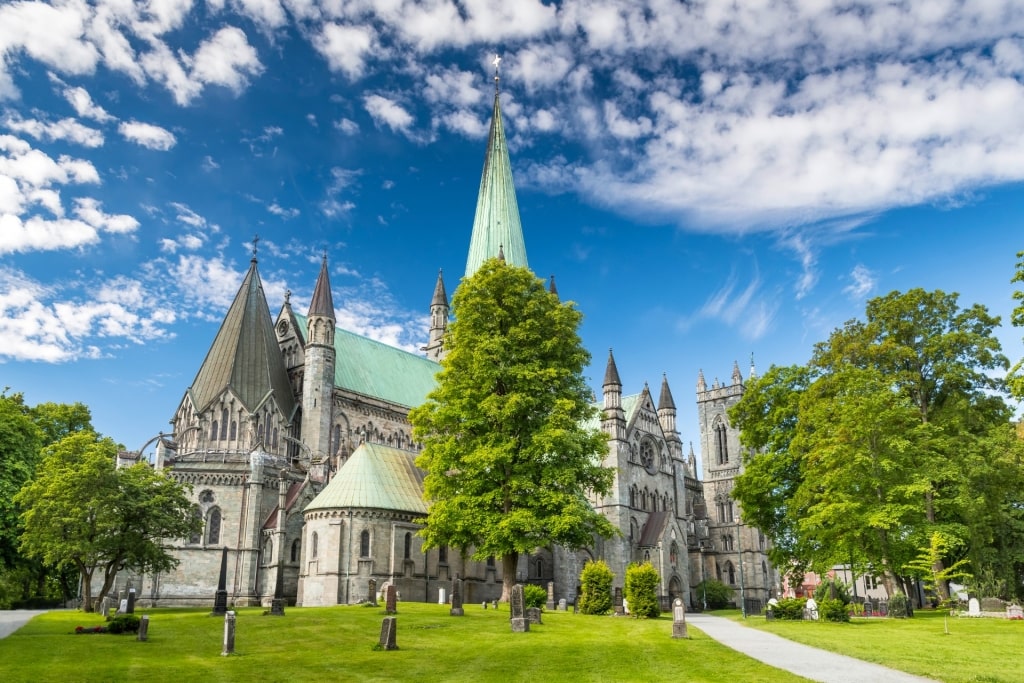
Nidaros Cathedral, Trondheim
Originally a wooden chapel, Nidaros has blossomed into a spectacular cathedral, with soaring towers, stained-glass windows, and stone sculptures, including 76 statues on the West Front.
It is a historic ritual that, upon arrival, pilgrims should walk around this gothic edifice three times. This is solid advice—providing plenty of opportunity for visitors to take in the church’s intricate details.
Join a guided tour of the cathedral or explore at your own pace, stopping to marvel at the jaw-dropping, 39-foot rose window and vaulted ceilings. After exploring inside the cathedral, step into the archbishop’s west wing to see the National Regalia Exhibition featuring Norway’s crown jewels, including the 20-carat-gold royal crown, adorned with pearls and gemstones.
Go Sea Kayaking From Ålesund Harbor
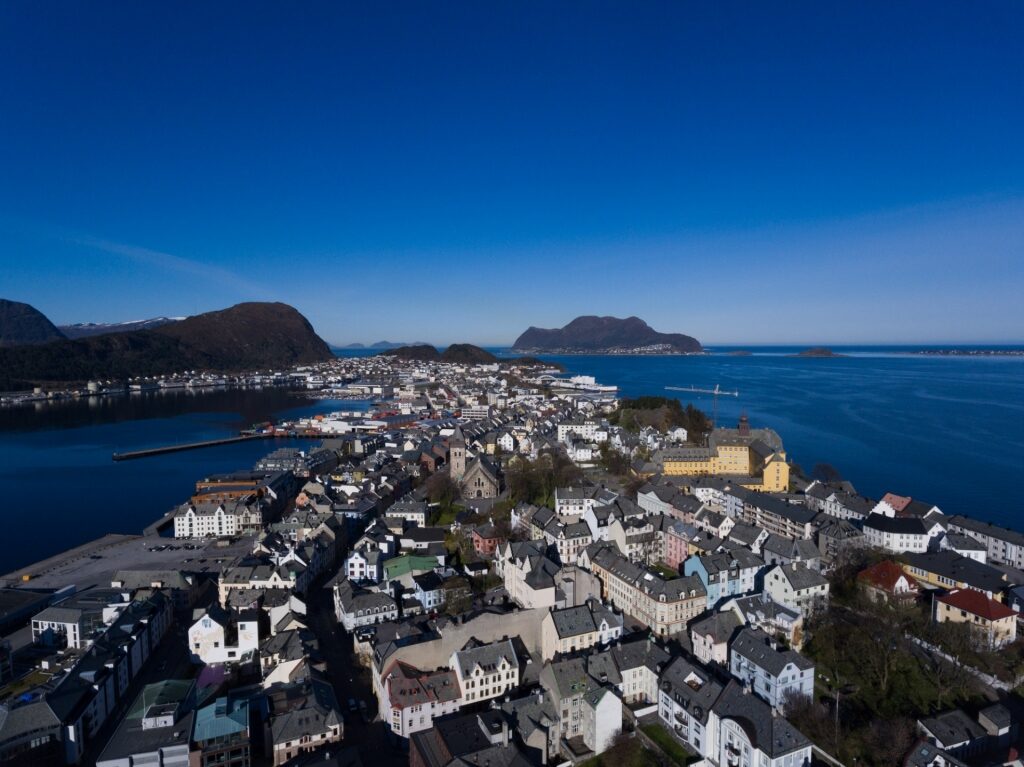
Ålesund
Kayaking is a wonderful way to explore a destination, particularly in outdoorsy Norway, with its historic harbors and deep fjords.
In Ålesund, at the entrance to the UNESCO Geirangerfjord, joining a guided kayak tour is one of the best things to do in Norway. Those who prefer an easier paddle can stick to the harbor area to see this pretty Scandinavian city and its famous waterfront Art Nouveau architecture from the inky water.
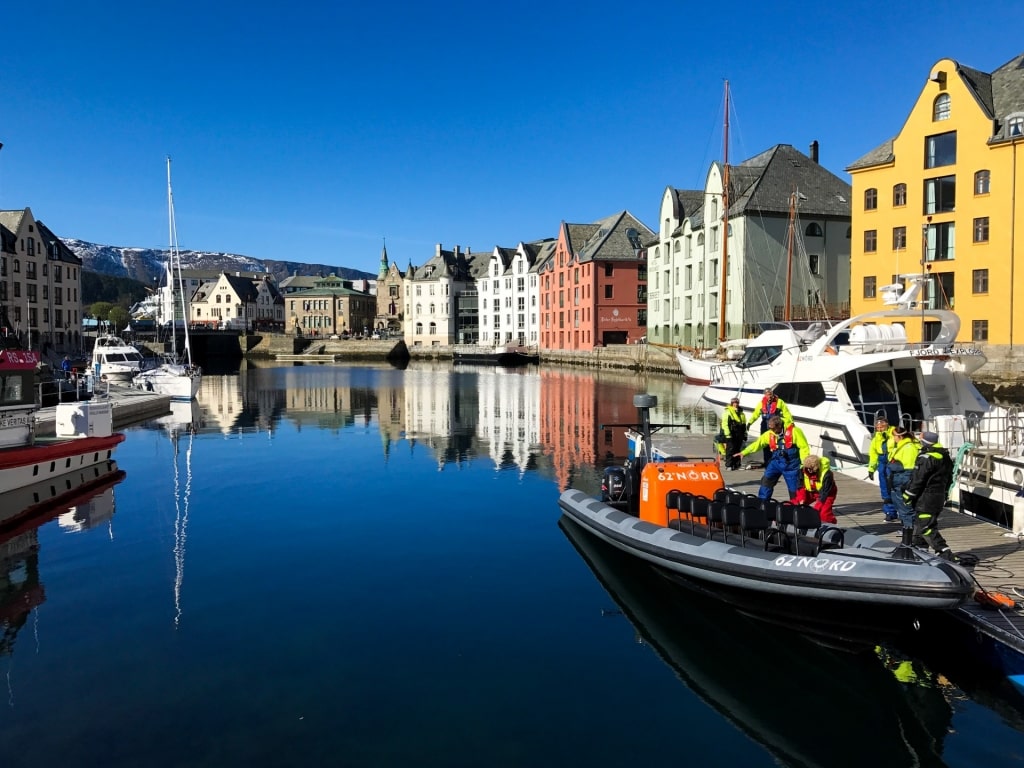
Ålesund
For an extended workout on the water, glide across the bay to Hessa Island, where you can join an exhilarating, though reasonably easy, hike to Mt. Sukkertoppen for sparkling views of the city. The latter involves roughly six miles of kayaking and a two-and-a-half-mile hike.
Other guided kayaking excursions delve into the handsome Tafjorden, part of the mighty Geirangerfjord. Here, breathtaking waterfalls, eagle and porpoise spotting, and tales of local folklore are typical. Whichever route you decide on, pack water, snacks, and a waterproof layer to stay dry.
Discover the pristine nature and intriguing culture of Norway on a cruise vacation. Browse our Norway cruises and start planning your next unforgettable vacation.
